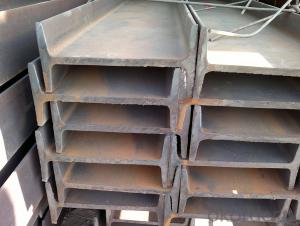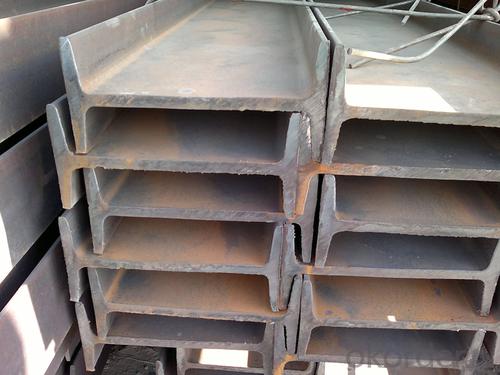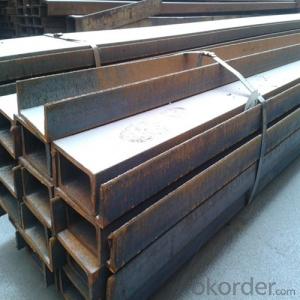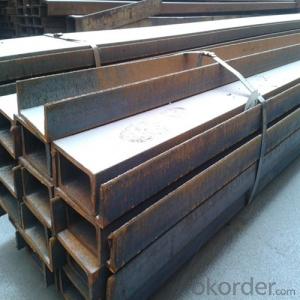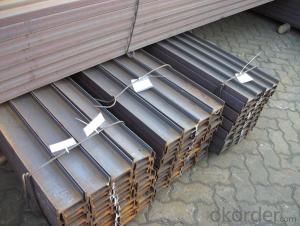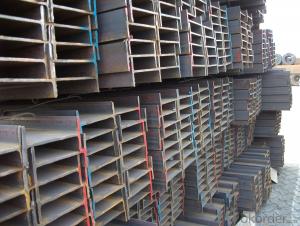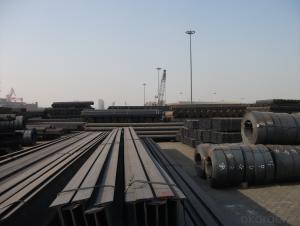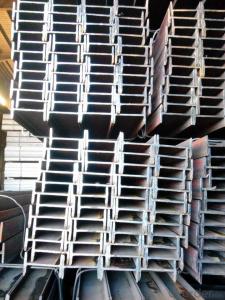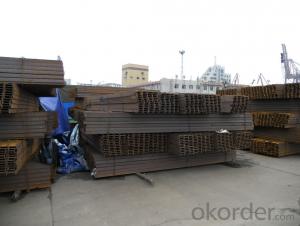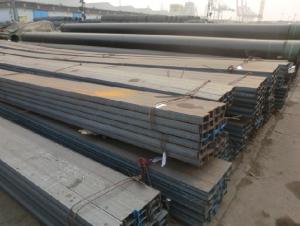IPE
- Loading Port:
- China Main Port
- Payment Terms:
- TT OR LC
- Min Order Qty:
- -
- Supply Capability:
- -
OKorder Service Pledge
OKorder Financial Service
You Might Also Like
Product Description:
IPE Beam Details:
| Minimum Order Quantity: | 10MT | Unit: | m.t. | Loading Port: | Tianjin Port, China |
| Supply Ability: | 10000MT | Payment Terms: | TT or LC |
Product Description:
Specifications of IPE Beam
1. Invoicing on theoretical weight or actual weight as customer request
2. Standard: EN10025, GB Standard, ASTM
3. Grade: Q235B, Q345B, SS400, ASTM A36, S235JR, S275JR
4. Length: 5.8M, 6M, 9M, 12M as following table
5. Sizes: 80mm-270mm
Dimensions(mm) | |||||
h | b | s | t | Mass Kg/m | |
IPE80 | 80 | 46 | 3.80 | 5.20 | 6.00 |
IPE100 | 100 | 55 | 4.10 | 5.70 | 8.10 |
IPE120 | 120 | 64 | 4.80 | 6.30 | 10.40 |
IPE140 | 140 | 73 | 4.70 | 6.90 | 12.90 |
IPE160 | 160 | 82 | 5.00 | 7.40 | 15.80 |
IPE180 | 180 | 91 | 5.30 | 8.00 | 18.80 |
IPE200 | 200 | 100 | 5.60 | 8.50 | 22.40 |
IPE220 | 220 | 110 | 5.90 | 9.20 | 26.20 |
IPE240 | 240 | 120 | 6.20 | 9.80 | 30.70 |
IPE270 | 270 | 135 | 6.60 | 10.20 | 36.10 |
Appications of IPE Beam
1. Supporting members, most commonly in the house raising industry to strengthen timber bears under houses. Transmission line towers, etc
2. Prefabricated structure
3. Medium scale bridges
4. It is widely used in various building structures and engineering structures such as roof beams, bridges, transmission towers, hoisting machinery and transport machinery, ships, industrial furnaces, reaction tower, container frame and warehouse etc.
Package & Delivery of IPE Beam
1. Packing: it is nude packed in bundles by steel wire rod
2. Bundle weight: not more than 3.5MT for bulk vessel; less than 3 MT for container load
3. Marks: Color marking: There will be color marking on both end of the bundle for the cargo delivered by bulk vessel. That makes it easily to distinguish at the destination port.
4. Tag mark: there will be tag mark tied up on the bundles. The information usually including supplier logo and name, product name, made in China, shipping marks and other information request by the customer.
If loading by container the marking is not needed, but we will prepare it as customer request.
5. Transportation: the goods are delivered by truck from mill to loading port, the maximum quantity can be loaded is around 40MTs by each truck. If the order quantity cannot reach the full truck loaded, the transportation cost per ton will be little higher than full load.
6. Delivery of IPE Beam: 30 days after getting L/C Original at sight or T/T in advance
Production flow of IPE Beam
Material prepare (billet) —heat up—rough rolling—precision rolling—cooling—packing—storage and transportation
- Q: Channel and I-beam are commonly used in construction sites. It is better to have on-site construction drawings, thank you
- Channel and I-beam are usually used to build floors.
- Q: How do steel I-beams compare to fiberglass I-beams in terms of strength and durability?
- Steel I-beams are generally considered to be stronger and more durable than fiberglass I-beams. Steel is a much stronger material compared to fiberglass, which means that steel I-beams can bear heavier loads and withstand more stress without deforming or breaking. Additionally, steel has a higher resistance to fire, extreme temperatures, and chemicals, which further enhances its durability. Fiberglass I-beams, on the other hand, are lighter and more flexible than steel I-beams. This makes them suitable for certain applications where weight is a concern or where flexibility is required. Fiberglass I-beams also have excellent corrosion resistance, making them ideal for environments that are exposed to chemicals or moisture. While fiberglass I-beams can be a cost-effective and corrosion-resistant alternative to steel in certain situations, they cannot match the strength and durability of steel I-beams in heavy-duty applications. Steel I-beams are commonly used in construction projects that require high load-bearing capacities, such as skyscrapers, bridges, and industrial buildings. In these scenarios, the superior strength and durability of steel make it the preferred choice.
- Q: What is called I-beam suspension outer shelf, what to do?.
- The steel suspension cantilever is to embed two pull rings on the floor board, to put the I-beam in it, to the outside of the floor, and then to fix the outside stand on the i-beam. This is a high-rise building commonly used as an external frame erection.
- Q: Can steel I-beams be used in curved or arched structures?
- No, steel I-beams are not typically used in curved or arched structures as their shape is not conducive to bending or curving. Other types of structural elements, such as curved steel beams or trusses, are typically used for such applications.
- Q: How long is a ton of 10# I-beam?
- You should be weighed or scale. This I-beam, there is a difference, there is national standard. Weighing 4500 yuan / ton. Generally less, are the ruler, the price of 4100 yuan per ton, and 3700 yuan per ton. Book with material. You take care of market goods. Not material, the price is relatively low.Excuse me, the weight of the 10 I-beam above is 11.261.. I mean the weight of the channel.
- Q: Can steel I-beams be used for parking structures?
- Yes, steel I-beams can be used for parking structures. Steel I-beams are commonly used in construction projects due to their strength and durability. They are capable of supporting heavy loads, making them ideal for parking structures that need to accommodate multiple vehicles. Additionally, steel I-beams can be easily fabricated and assembled, offering flexibility in design and construction. The use of steel I-beams in parking structures allows for the creation of wide, open spaces without the need for excessive columns or support structures, maximizing the available parking space. Overall, steel I-beams are a popular choice for parking structures due to their structural integrity, cost-effectiveness, and ability to support the weight requirements of such facilities.
- Q: How do steel I-beams perform in areas with high levels of chemical exposure?
- Steel I-beams perform well in areas with high levels of chemical exposure due to their inherent resistance to corrosion. The steel used in I-beams is typically coated with protective layers, such as galvanized coatings or epoxy paint, which act as barriers against chemical substances. This helps prevent the steel from reacting with or being damaged by corrosive elements present in the environment. Furthermore, the structural design of I-beams, with their sturdy shape and cross-sectional properties, enhances their ability to withstand chemical exposure. The I-shaped profile provides high strength and load-bearing capacity, making them suitable for heavy industrial applications, including those involving chemical processing plants, refineries, or wastewater treatment facilities. However, it is important to note that not all chemicals have the same impact on steel I-beams. Some highly acidic or alkaline substances, as well as certain solvents or aggressive chemicals, may still cause corrosion or deterioration of the protective coatings over time. Therefore, it is crucial to select the appropriate type of steel, protective coatings, and maintenance practices based on the specific chemicals present in the area to ensure the long-term performance and durability of steel I-beams in such environments. Regular inspections, maintenance, and prompt repair of any coating damages or signs of corrosion are also recommended to extend the lifespan of the I-beams and maintain their structural integrity.
- Q: How do you calculate the shear force in a steel I-beam?
- To calculate the shear force in a steel I-beam, you need to determine the applied load or external forces acting on the beam. Once you know the magnitude and distribution of these forces, you can analyze the beam's cross-section to determine the shear force at any specific point. This involves considering the equilibrium of forces and moments acting on the beam, as well as understanding the shear flow and the properties of the beam's materials. Using these principles, you can calculate the shear force at different locations along the beam.
- Q: How do steel I-beams handle lateral loads, such as wind or earthquakes?
- Steel I-beams are designed to handle lateral loads, such as wind or earthquakes, quite effectively. The shape and structural properties of I-beams make them highly resistant to bending and twisting forces. The flanges of the I-beam provide stiffness and strength, while the web resists shear forces. Additionally, steel's high strength-to-weight ratio allows I-beams to handle significant loads without excessive weight. These factors enable steel I-beams to effectively resist lateral loads and maintain structural stability during wind or earthquake events.
- Q: Can steel I-beams be used for pharmaceutical facilities?
- Pharmaceutical facilities can indeed utilize steel I-beams. These beams are frequently employed in construction for their robustness, longevity, and ability to bear heavy loads. In pharmaceutical facilities, where there is a need for various weighty equipment, machinery, and storage systems, steel I-beams offer the vital structural support. Furthermore, steel I-beams possess resistance to fire, pests, and chemical damage, rendering them an excellent choice for pharmaceutical facilities that demand strict adherence to safety and cleanliness standards. Additionally, steel I-beams can be tailored to meet specific design requirements, enabling flexibility and efficient utilization of space in pharmaceutical facilities. In summary, steel I-beams are a dependable and pragmatic option for the construction of pharmaceutical facilities.
Send your message to us
IPE
- Loading Port:
- China Main Port
- Payment Terms:
- TT OR LC
- Min Order Qty:
- -
- Supply Capability:
- -
OKorder Service Pledge
OKorder Financial Service
Similar products
Hot products
Hot Searches
Related keywords
